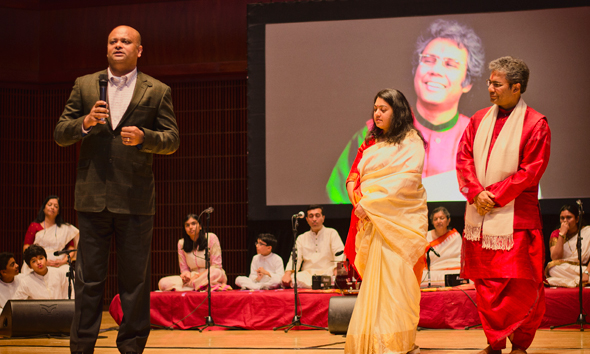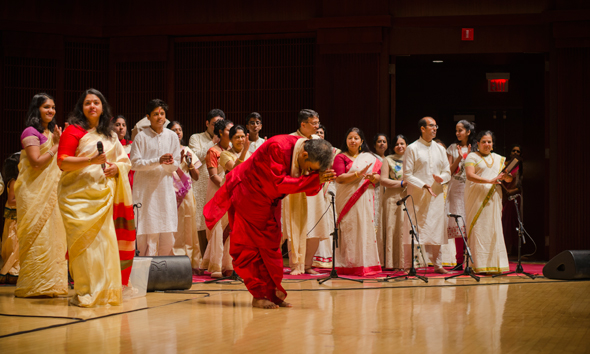Saadhana Pariwar’s “Spectrum” Brings out an Array of Musical Colors
By Sanchali Basu
HOUSTON: As the spectrum in a rainbow has 7 colors, the “Spectrum” presentation by students of Pandit Suman Ghosh and Shashikala Ghosh’s Saadhana Pariwar, brought out the best of the seven musical notes. Attended by dignitaries like CGI Dr. Anupam Ray, Rathna Kumar, Dr. Mathur, Govind Shetty, Sonal Buchar and many more, the afternoon of October 15, at the Rice University Shepherd School of Music was indeed a musical treat.
Pandit Ghosh aptly chose the Sarang ragas (early afternoon) to set the tone of the program. He and his almost 80 students delighted the audience with a good selection of Sarang ragas, beginning with an invocatory bandish, a creation of Sangeet Martand Pandit Jasraj in Shudh Sarang, “Jao ji jao Shyam Chhaliya,” followed by “Piu palan laagi mori ankhiyan” in Gaud Sarang and a composition by Jnan Prakash Ghosh (one of Pandit ji’s gurus) in raga Brindavani Sarang.
The next set of compositions that were presented was in the Malhar raga, and Panditji mentioned the significance of Tansen’s “Miya ki Malhar” which brought rain in Akbar’s court while he sang. In modern day context, Panditji referred to his guru, the Sangeet Martand who had sung, “Barkha hritu aayi” in the Dhuliya Malhar in Delhi once on an otherwise clear day in the peak of summer and it had started pouring cats and dogs. The Surdasi Malhar, Bin barasan ka chhaye badarwa” was noteworthy.
The meditative, mysterious, soothing late night Kauns ragas were then offered by the choir of exceptionally well trained students. Panditji mentioned that each of the students ranging from the age of 8 to over 60 were all capable solo singers in their own right and commended them on being able to keep up with the constant extemporary improvisations as the raga demands.
Emcee Sunanda Vashisht informed the audience about the style of Haveli singing which preceded Khayals by 200 years. Haveli sangeet in Raga Patdeep, composed by Pandit Jasraj, was then performed by the budding musicians. It was good to know that this genre of music has been revived, popularized and taken to towering heights by the Sangeet Martand, and now by his worthy torchbearer, Pandit Suman Ghosh.
The spring time Shringaar and Bhakti rasa were brought out in the Bahar ragas, ranging from Hindol, Khamaj, Basant and Bhairav. Carnatic flavor was added to the evening with the Kanada class of 3 ragas – Kaunsi, Suha, Gunji. ‘Khelo na ham sang Hori’ in Nayaki Kanada was a delight to the ears. The Nagadhwani Kanada was a composition by Pandit Motiram ji – Dada Guruji (father of Pandit Jasraj) who died in 1934.
The grand finale on Darbari Kanada (raga of the kings and King of the Ragas) – Har har har Bhootnath Pashupati, and the excellent Sargam medley on rare raga Hemvati, took the audience on a spiritual high. With permission from the CGI who went “wah wah” and “Bahut acchhe” throughout the course of the program, the evening ended with a bhajan, “Man tohe..Satya ki raaha chalaaun”. The latter talked about the mind which is the most powerful tool and control of the mind can be attained by simplicity and following the path of truth. The composition is by Sant Kabir and was set to music by Pandit Suman Ghosh.
Dr. Anupam Ray commended and applauded the guru and students for upholding and transplanting 5000 years of culture and classical music in the Vedantic tradition. Guruji and Guruma thanked and acknowledged all participants and volunteers in the background. Several members were awarded the Saadhana Gaurav certificate and Archana Tripathi was awarded the Saadhana Rathna award.



